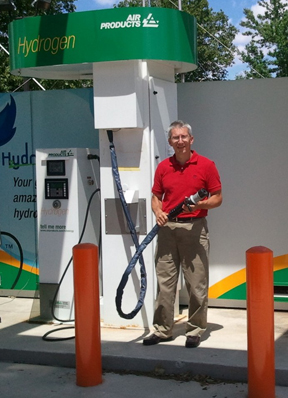By Matt Sinclair ’90

David Farese '88 at an H2 fueling station at Air Products
The fuel-efficient hydrogen-powered car is no longer the stuff of science fiction; indeed, all of the major automotive companies have large fuel-cell vehicle programs.
Among those at the heart of the movement is David Farese ’88, engineering manager for the Hydrogen Energy Systems group of Air Products, Allentown, Pa., which designs, builds, and installs hydrogen (H2) fueling stations around the world.
“The fuel cell produces the electricity on board from hydrogen, rather than needing to plug in,” says Farese. “Carrying hydrogen means that a fuel-cell car can easily obtain a 300- to 400-mile range. They can also be refilled at an H2 fueling station in a similar manner as a traditional gasoline station within three to five minutes.” He adds that H2 fuel-cell vehicles are quiet, powerful, produce zero emissions, and are more than twice as efficient as most on-road vehicles powered by fossil fuels.
Hydrogen can be produced on a mass scale domestically from natural gas, as well as from biogas sources such as landfills, digesters, wastewater treatment systems, and from electricity produced from wind, solar, or nuclear power. Air Products fueling stations dispense H2 for fuel-cell vehicles from all of these sources, says Farese, a mechanical engineering graduate. He has been developing products for H2 fuel stations since 1997, and his team has built more than 130 stations in nearly 20 countries.
One challenge has been developing the infrastructure to enable vehicles to refuel easily at multiple hydrogen fueling station locations. Already, several markets have fuel-cell vehicles deployed in large numbers.
“For example, in the material handling industry, there are currently over 2,000 forklifts operating on hydrogen-powered fuel cells and this number is growing quickly,” Farese says. “These offer significant operating and productivity improvements compared to battery-operated forklifts, which have long recharge times, batteries that wear out quickly, and environmental issues.”
Fuel-cell vehicles are not yet as economical as gas-powered cars because of the cost to produce them. However, if they were mass-produced today, Farese says they would approach the cost of high-end hybrid cars, and still have tremendous additional potential to drive costs further down.
To some, hydrogen conjures up frightful images of explosions, but Farese explains that as long as its properties are understood, hydrogen can be as safe, if not safer, than gasoline.
“The H2 is stored in very robust high-pressure storage tanks that are virtually impervious to external impact,” he says. “The systems are also designed to meet stringent codes, in similar fashion to compressed natural gas vehicles, of which there are millions in use worldwide. Numerous safety features are built into the vehicles and fuel stations that make them safe to operate.”
Another challenge has been how hydrogen is regulated, and Farese has been deeply involved in that effort as a member of the U. S. Department of Energy’s Hydrogen Safety Panel, the National Fire Protection Association (NFPA) 52 Technical Committee, NFPA 2 Technical Committee, and Hydrogen Industry Panel on Codes.
“For many of the existing codes and standards hydrogen was not thought of as a retail fuel. As a result, it was not included in the general text for fueling stations, etc.,” he says. “This is a large effort that takes a long time, but has been very successful. H2 is now integrated into the major codes and standards.”
Will H2 filling stations be commonplace by the end of this decade?
“I fully expect that in certain locations such as Los Angeles, H2 will be commonplace,” he says. “I don’t expect it to be widespread throughout the country yet, but it will likely expand rapidly at that point.”
Farese values the experience and education he received at Lafayette. He is married to Janice Seazholtz Farese ’88, a mechanical engineering graduate.
